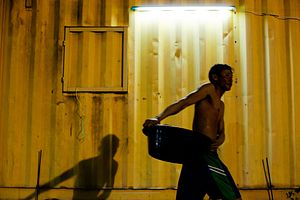BANGKOK — In a small community located on the outskirts of Bangkok, about 300 migrant construction workers live with their children in a set of dismountable houses built of recycled yellow shipping containers. When the construction work finishes, they will move the camp to a new location elsewhere.
Most of the residents are originally from impoverished neighboring countries such as Cambodia, Myanmar, and Laos. The company they work for provides them with housing, water, and electricity, so they can send money to their families.
“We had no work at home, that’s why we came here,” says Doun, 30, who was farming for a dollar a day in the Cambodian countryside.
Male workers receive the Thai minimum wage of 300 THB per day (about $8.5), while women receive 245 THB ($6.5) a day, a salary below average.
The conditions inside the shipping container homes are very austere. The rooms have a mattress on the floor, mosquito nets, and a clothes rack. The spaces also have a fan to relieve the suffocating air inside the metal boxes in a country where temperatures are high throughout the year.
Some areas inside the suburb are communal, such as the showers or toilets. These are shared by all the neighbors, so right after work they are crowded with people showering and doing laundry.
This particular suburb is home to seven children who are between nine months and 12 years in age. The kids can go to a school erected for them a few meters from their homes, where they play and receive basic education.
According to Amela Mujagic, program manager of the International Organization for Migration in Thailand, there are currently around 500,000 construction workers in Thailand. Most of them were previously engaged in fishing or agriculture, two industries heavily damaged by droughts in recent years.
The place does not have many commodities, but has become a community of neighbors with whom to share the long days away from home.
Antolín Avezuela is a photojournalist based in Bangkok, Thailand.
Ana Salvá is a freelance journalist based in Southeast Asia.
















































